The NASJE Board and the ad hoc Strategic Planning Committee are very pleased to provide the NASJE 2015-2020 Strategic Plan: PDF
Thank you to everyone who participated in the process of developing this document.
The NASJE Board and the ad hoc Strategic Planning Committee are very pleased to provide the NASJE 2015-2020 Strategic Plan: PDF
Thank you to everyone who participated in the process of developing this document.
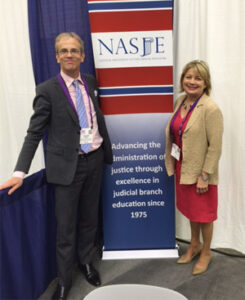
NASJE is being represented at the Court Technology Conference (CTC) in Minneapolis this week by Past Presidents Jill Goski and Joseph Sawyer.
CTC is the largest court technology conference in the world, bringing together more than 1,500 court professionals for three days of learning, training and networking.
NASJE has a booth in the Exhibit Hall, spreading the word about our spectacular member benefits and resources available to the judiciary.
Just for fun, here is a link to an article about the very first CTC in 1988: PDF
NASJE members, met with author Dr. James Loewen via webcast to be held on Thursday, October 1 at 12:00 Pacific/3:00 Eastern!
Dr. Loewen is the author of the books Sundown Towns and Lies My Teacher Told Me , which speak to educators about the destructiveness of inaccurate and misleading teaching and about persistent racism in the United States. Dr. Loewen is leading the experiential learning event at NASJE’s 2015 annual conference in Seattle, and this webcast will help launch the broader discussion we will undertake at the conference. Even if you aren’t attending the conference, this webcast will introduce you to topics of importance to judicial educators in today’s America and in our criminal justice system.
, which speak to educators about the destructiveness of inaccurate and misleading teaching and about persistent racism in the United States. Dr. Loewen is leading the experiential learning event at NASJE’s 2015 annual conference in Seattle, and this webcast will help launch the broader discussion we will undertake at the conference. Even if you aren’t attending the conference, this webcast will introduce you to topics of importance to judicial educators in today’s America and in our criminal justice system.
In 1969, while teaching at Tougaloo College, a black school in Mississippi, Dr. Loewen discovered an astonishing fact: His students had learned history in high school, but the history was inaccurate, misleading, and destructive. This experience prompted Loewen’s journey, spanning over 30 years, in which he uncovered how students were taught bad history, why students were taught bad history, and surprising findings about racism in the United States.

You can read more about Dr. Loewen and purchase his books at Amazon
Dr. Loewen will sign your book at the conference. Don’t forget, NASJE participates in the Amazon Smile program.
Check for an email to members about registration, or contact Sarah Dahl at the National Judicial College for the registration link.
by Kelly Tait

Fall greetings! Hopefully you enjoyed our summer of webinars. My thanks to the Western Region, the Midwestern Region, the Education Committee, and the National Judicial College for their creativity, organization, and support on the webinars! There are more to come—we will have regularly featured webinars throughout the year. Also see below for two that are scheduled in the next few weeks as part of the lead-up to our Annual Conference in Seattle in October.
But a drumroll first … the NASJE Board and the ad hoc Strategic Planning Committee are very happy to present a final draft of NASJE’s 2015-2020 Strategic Plan (PDF) for comments from NASJE members. It’s a forward-looking document that will help guide our efforts for the next five years. Many thanks to everyone involved in getting the plan to this point; kudos to Lee Ann Barnhardt (ND) in particular for her leadership as chair of the committee.
We would love your feedback on the plan before it is finalized! There are a couple of different ways for you to comment on it (these of course are in addition to the opportunities we’ve provided over the past year and a half for input on various aspects of the plan). One is to attend any portion of the webcast we’ve arranged on Wednesday, September 23. We’ve planned a two hour “open house” webcast for members to discuss the plan, ask questions of many of the people directly involved in the development of it, and provide comments. The webcast will be on 9/23 from 12:00-2:00 PM PDT/ 1:00-3:00 PM MDT/ 2:00-4:00 PM CDT/ 3:00 PM – 5:00 PM EDT. Please see the article on the strategic plan to register for the webcast.
You can also email your comments about the strategic plan to me directly at ktconsulting@aol.com – please email them by Friday, September 25, at 5:00 PM PDT if you’d like them considered before the plan is finalized.
On another topic, we are excited to have a pre-conference webcast with Dr. James Loewen, a sociologist and author of Sundown Towns and Lies My Teacher Told Me, to help set the stage for the Experiential Learning Opportunity he will be leading in Seattle at our Annual Conference. The webinar is Thursday, October 1, at 12:00 Pacific/3:00 Eastern. All members are welcome to participate in the webinar even if you won’t be able to attend the conference. Information on how to join the webinar has been emailed to members and will be emailed again in advance of the webinar. (If you don’t receive it, please let me know.)
I do hope you will be joining us in Seattle for our Annual Conference on October 4-7, which is being held in conjunction with the American Judges Association and the State of Washington AOC. There are numerous high-quality education sessions being offered, and networking opportunities as well. (You can still register.) If you’re unable to attend, we will be highlighting many of the plenary sessions on this website following the conference.
I will wrap up my term as NASJE President on October 7 — it has been a privilege and a pleasure! We are in good hands with both the current and incoming Board members. I urge you to consider becoming more involved in the leadership of our vibrant organization.
Warm regards,
Kelly Tait, NASJE President
ktconsulting@aol.com
P.S. Remember that you can help NASJE get small donations at no cost to you if you shop on Amazon.com through the AmazonSmile program. To sign up for this program, go to smile.amazon.com then to the drop-down menu “Your Account.” Click on “Change Your Charity,” then under “Pick your own charitable organization” choose “National Association of State Judicial Educators C/O CJER.” Amazon will then donate a half of a percent of the purchase price to NASJE (at no cost to you). For this to happen, be sure sign on to Amazon via smile.amazon.com each time you
Reviewed by Nancy Smith, Pima County, Arizona Field Trainer and NASJE member
Be prepared to be outraged.
 In his compelling book, The Divide: American Injustice in the Age of the Wealth Gap, Rolling Stone editor Matt Taibbi builds a compelling case about inequality in the American criminal justice system, charging that one’s wealth or lack thereof largely affects how one fares in it. Mr. Taibbi demonstrates convincingly how and why Wall Street bankers, traders and hedge fund operators have never been convicted of crimes for their roles in the 2008 recession — and it isn’t pretty. The tableau he paints shows that despite convincing evidence of their crimes, those able to afford expensive lawyers get off without criminal convictions.
In his compelling book, The Divide: American Injustice in the Age of the Wealth Gap, Rolling Stone editor Matt Taibbi builds a compelling case about inequality in the American criminal justice system, charging that one’s wealth or lack thereof largely affects how one fares in it. Mr. Taibbi demonstrates convincingly how and why Wall Street bankers, traders and hedge fund operators have never been convicted of crimes for their roles in the 2008 recession — and it isn’t pretty. The tableau he paints shows that despite convincing evidence of their crimes, those able to afford expensive lawyers get off without criminal convictions.
On the other hand, the poor are subject to Broken Windows policing and stop and frisk policies that cause them to be detained and subject to search and arrest for no other reason than being there. Welfare recipients are routinely convicted, jailed, and refused future benefits because of errors in the system, and their homes and belongings searched without just cause. Large segments of the minority and poor populations have criminal convictions and/or have served jail time for truly minor “crimes,” or for no reason at all. According to Mr. Taibbi, this happens because they are poor and powerless—and often because of their race.
The picture Mr. Taibbi paints is disturbing, and the information he provides is indispensable. His arguments show diligent and thorough research. He quotes statistics and well-known social science researchers and members of the Justice Department, as well as members of various police forces and the victims and victors themselves. Just when you think you understand the criminal justice system, this book jars you into realizing how much more there is to learn and to work to change.
The Divide is essential reading for anyone who works in the criminal justice system and would be an interesting (and perhaps controversial) Law and Literature or book club selection.
But, be prepared to be outraged.
By Jeff Schrade, Director of Education Services, Arizona Administrative Office of the Courts
NOTE: Jeff Schrade will lead a session on this topic at NASJE’s annual conference in October in Seattle, where he’ll be available to answer your questions and discuss Arizona’s process.
Judicial educators create opportunities for transformative education that strengthens the administration of justice. One of the most important and valuable transformations we can facilitate is that from new hire to supervisor, manager, executive and beyond. It is just this sort of defined career pathway that attracts bright and justice-oriented individuals to a career in the courts. We also know that the courts sit on the edge of a demographic cliff, with Baby Boomers retiring in record numbers for at least the next decade. To face this challenge, we must recruit justice-minded individuals and keep them engaged in their work, while also developing professional competencies that prepare them for increasing responsibility and leadership.
In addition to these immediate demographic challenges, change itself keeps changing, and the pace of change continues to accelerate. We see this most visibly with rapidly-changing computer technology, but also with changing expectations from our communities as new drugs, crime trends, and treatment options emerge. Leaders in the judicial branch must be adaptable and pilot courts through a dynamic environment. In short, we need smart, creative, passionate, capable and well-prepared leaders who are committed to the profession of court management.
So how do we get there? We’re presented with at least two different approaches: (1) we recruit from outside of the courts or (2) we develop leaders from within. While colleges of public administration and law can produce some court employees, there are too few formalized court management programs that teach the knowledge and skills necessary to effectively administer a court. Often even highly-qualified candidates from outside of the courts need significant training and development – for example on managing caseflow. These factors taken together convince me that our state courts will have to be in the business of developing leaders for the foreseeable future.
Leaders of the Arizona Judicial Branch also considered this conclusion over a decade ago along with other environmental challenges specific to Arizona:
In 2006, Chief Justice of the Arizona Supreme Court Ruth McGregor established the Court Leadership Institute of Arizona to “develop meaningful, comprehensive management and leadership programs for current and future court leaders to use in advancing the administration of justice in Arizona” (AO 2006-69). Soon after, a committee of court administrators, judges, probation leaders and academics appointed by the Chief Justice began developing this leadership training program.
The committee initiated an intensive multi-year curriculum development project. Beginning with a fairly expansive needs assessment, the committee focused on developing a tiered-competency model with the first tier serving new supervisors, the second serving seasoned managers, and higher tiers serving those in executive management positions.
The committee focused a considerable amount of time identifying content areas and developing learning objectives for each tier, influenced by direct local input as well as by national models such as the National Association for Court Management (NACM) core competencies. It was only after the content areas and learning objectives were well-defined that the committee shifted focus to developing curriculum to meet the learning objectives. Fortunately the Institute for Court Management (ICM) had an existing national curriculum that met many of the learning objectives developed by the committee.
Arizona had been offering court management certification training programs locally since 1998 through a partnership with ICM. However, the existing arrangement couldn’t scale to impact the potential audience identified in Arizona courts – there are approximately 10,000 employees and judges in Arizona’s courts including 2,500 probation officers and support personnel. With many other states facing similar challenges, ICM formed a 7-state consortium to revamp its curriculum and create a model that would deliver national certification courses locally (to scale) in participating states.
As curriculum was developed for the ICM consortium, the Arizona Court Leadership Institute committee aligned the six manager-level ICM courses and six executive-level ICM courses to content areas and learning objectives in each tier of the Arizona program. However, the ICM courses did not cover all of the areas identified by the committee. The Education Services Division of the Arizona AOC developed new curriculum to meet these learning objectives:
Additionally, the ICM curriculum did not cover general management and supervision skills necessary for new supervisors entering the first tier of the program. Realizing the crucial need for a first-tier leadership curriculum that prepares promising employees for advancement into management, the committee set out to develop a new stand-alone curriculum for new supervisors.
However, the committee soon realized that the quantity of courses needed for the entry-level supervisor tier was beyond the capacity of the Arizona AOC to produce. Coupled with the practical concern that most first-tier supervisors should not be away from their job assignments for extended amounts of time, this lead the committee to adopt a blended model with self-paced online courses for key content, and live webinars and in-person classes to practice, discuss and further develop supervisory skills.
The committee selected a mix of existing computer-based trainings produced by the AOC and off-the-shelf entry-level supervision courses from SkillSoft, a large private national learning provider. Participants take the self-paced online classes and complete worksheets that are submitted, along with a transcript of class attendance, to certify completion of the Arizona Court Supervisor program. Self-paced online classes cover conflict resolution, problem solving and decision making, coaching and employee relations, effective communications and meetings, team building and employee motivation, setting priorities, change management, purposes and responsibilities of courts, visioning and strategic planning, legal information vs. legal advice, and security/emergency preparedness.
The Supervisor program also uses live webinars and in-person classes to address complex topics, and to develop essential supervisor skills. Live webinars include transition to the role of supervisor and supervisory ethics. Four in-person classes lasting one or two days cover human resources management, supervisor’s role in case management, essential components of probation supervision, leadership, role of courts, records management, public education, media, policy, organization, workflow processes and accountability.
Although the committee discussed sending individuals through the program as a strict cohort, participants can complete courses in any order within a 7-year time span (required by ICM). Nevertheless, most participants complete the program together, forming a connection with one another that contributes to the effectiveness of the program. The Supreme Court hosts graduation celebrations for each tier that are usually well-attended by the families and professional colleagues of program graduates.

Recently many local courts have started to include this program’s certifications as “preferred” in recruitments. We believe this provides great value to graduates of the program while at the same time strengthening the candidate pool for local court recruitment.
The Arizona Court Supervisor (ACS) program courses were offered starting in 2012, and the first class of 42 “Arizona Court Supervisors” graduated in March 2014. Today, the ACS program has 126 active participants.
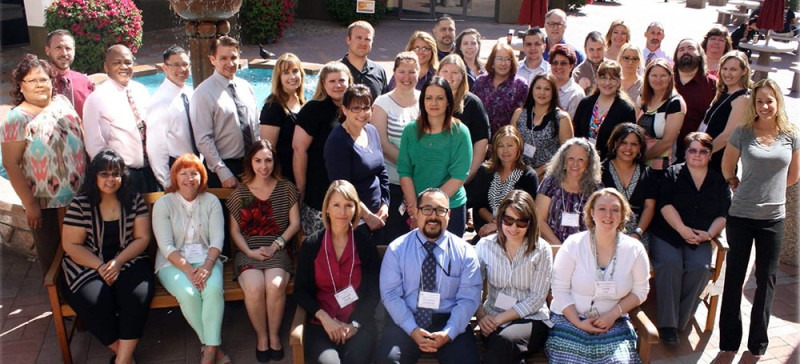
The Arizona Court Manager (ACM) program courses were offered starting in 2008, and the first class of 48 “Arizona Court Managers” graduated in May 2010. Today, the ACM program has 75 active participants and a total of 169 court leaders have graduated from the program.
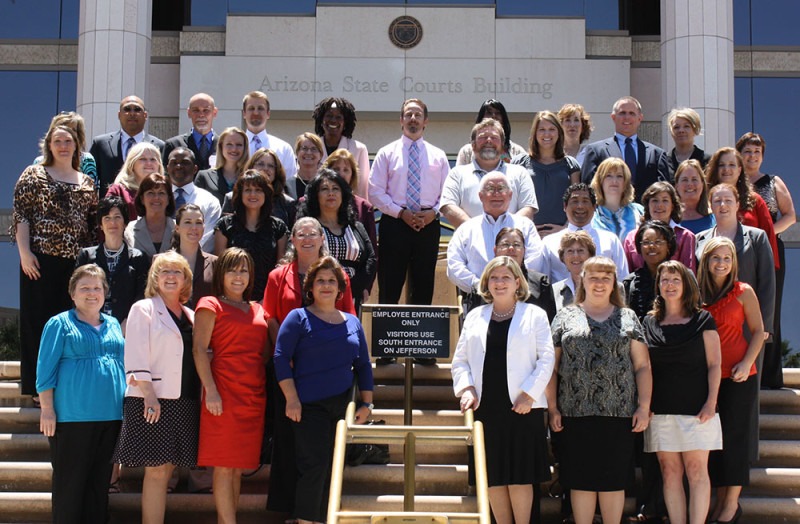
The Arizona Court Executive (ACE) program courses were offered starting in 2011, and the first class of 29 “Arizona Court Executives” graduated in November 2013. Today, the ACE program has 34 active participants and a total of 33 graduates.

The leadership program has also produced a remarkable increase in ICM Fellows from Arizona. The 2014 ICM Fellows class had 11 individuals from Arizona out of a total class of 19. This was followed by 3 Arizonans in the 2015 ICM Fellows class and 4 participating in the ICM 2016 Fellows class.
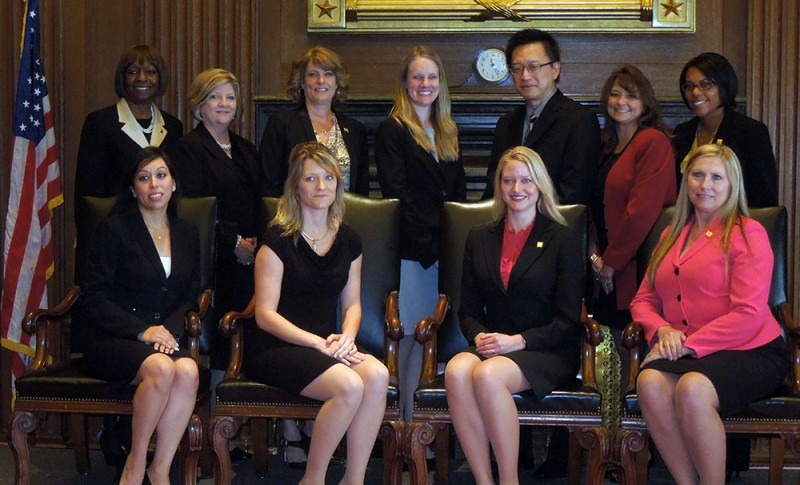
It is no surprise that the tiered design of the Arizona Court Leadership Institute is producing so many new ICM Fellows. In fact, retention and progression have emerged as tangible benefits of this model. As the figure below illustrates, the model provides a clear path for professional development from hire to achieving the highest professional certification as an ICM Fellow.
High-potential employees complete the Arizona Court Supervisor program in 18-36 months while making the transition from “bud to boss” and assuming supervisory duties. Successful supervisors can then enter into the Arizona Court Manager program – another 18-36 months of study. Experienced managers then continue to 18-48 months of the Arizona Court Executive program, and then on to the 2-year ICM fellows program. This path can take between 6 and 14 years, potentially spanning a significant part of one’s career.
Each program requires an application to be completed by the participant, their direct supervisor and their court’s chief administrative officer. This states an explicit commitment from the participant, their supervisor, and their court leadership to complete the program. Although not all participants in any given tier will advance to the next, the program taken together provides a powerful incentive for individuals to stay in the courts, and to continue developing as a leader within the profession.
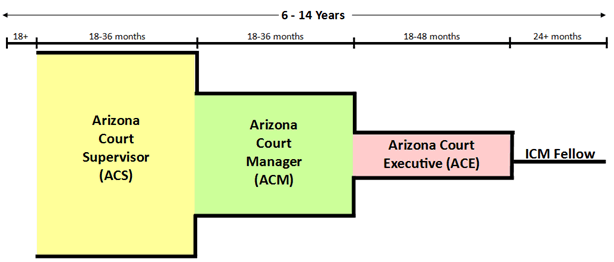
Cappelli, Peter. Harvard Business Review March 2008. “Talent Management for the Twenty-First Century.” https://hbr.org/2008/03/talent-management-for-the-twenty-first-century
Charan, Drotter and Noel. The Leadership Pipeline: How to Build the Leadership-powered Company. Jossey-Bass, 2001. http://www.amazon.com/dp/0470894563
Colby and Ortman. United States Census Current Population Reports May 2014. “The Baby Boom Cohort in the United States: 2012 to 2060” https://www.census.gov/prod/2014pubs/p25-1141.pdf
Conger and Fulmer. Harvard Business Review December 2003. “Developing Your Leadership Pipeline” https://hbr.org/2003/12/developing-your-leadership-pipeline
Martin and Wagenknecht-Ivey. NCSC Future Trends in State Courts 2011. “It’s a New Day: Future Trends Require Revolutionary Changes in Courts” http://www.ncsc.org/sitecore/content/microsites/future-trends-2011/home/Enhancing-Access/5-2-Its-a-New-Day-Future-Trends-Require-Revolutionary-Changes-in-Courts.aspx
NASJE Webinar: Law and Literature with Tim Baland
Date: September 2, 2015
Time: Noon-1:15 p.m. CDT
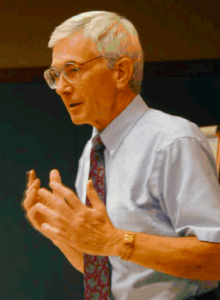
Save the date for this fun and informative webinar! NASJE members will be emailed information on how to participate prior to the event.
Join the Education and Curriculum Committee on Wednesday, September 2, 2015, in a webinar — Law & Literature with Tim Baland. The webinar will be held at 10:00am Pacific / 11:00pm Mountain / Noon Central / 1:00pm Eastern.
Mr. Baland will facilitate a 75-minute interactive session based on Pearl S. Buck’s short story “The Enemy“. His capsule summary of how the “Literature for Lifelong Learning” program typically works for judges follows:
Participants read one or more works of literature (typically a short story) in advance. The program itself involves a discussion by the participants of professional practice and professional responsibility issues, with discussion questions posed by the facilitator. The facilitator’s role is to pose questions which encourage participants to tap into their life experience, and to share with each other their ideas, insights and perspective on the issues that come up for discussion.
The issues that come up for discussion are usually a function of one of two things: either the theme or “purpose” of the program; or a function of the type of continuing judicial education (CJE) credit that participants earn through their attendance and participation. These programs have been approved for ethics and professional responsibility CJE credit in every jurisdiction where they have been offered.
Lastly, Lee Ann Barnhardt, North Dakota’s State Judicial Educator, will spend a few minutes sharing her experiences, both with Tim Baland’s services in teaching North Dakota judges and in using her own teaching skills and background to offer “Law and Literature” sessions to clerks and juvenile probation officers in that state. Not only will you have the opportunity to hear how one of your colleagues utilized this judicial education format and ask follow up questions, but you will have a model for using it in your own state. As if that weren’t enough, by attending the webinar you will engage in 75 minutes of professional development for yourself discussing topics related to diversity and ethics. We hope to “see” you there!
The National Center for State Courts just published the 2015 installment of “Trends in State Courts.” Several of the national court leaders published in the 2015 Trends in State Courts have connections to NASJE:
The full NCSC 2015 Trends in State Courts publication is available at the NCSC website. The full text of past “Trends” articles, categorized by topic, are also posted on the site.
And speaking about…
NASJE member Nancy Smith and NASJE President-elect Margaret Allen both delivered sessions at the NACM mid-year conference in Austin in February, 2015. Margaret, an Education Program Manager at the Supreme Court of Ohio, presented You Want Justice with That? What Court Employees Need to Know; while Nancy, a court trainer for Pima County Courts in Tucson, Arizona, presented “Teaching Due Process to Court Staff: How and Why”.
NOTE: NASJE members may find the link to the video replay of this Webinar in our member area.
NASJE Webinar: Format and Functionality of Bench Books in the Age of Technology
Date: July 22, 2015
Time: Noon-1:30 p.m. CDT

Judges have referred to Bench Books for guidance for a very long time, but due to technological advances, this resource is changing rapidly. Join Dawn McCarty, Director of the Michigan Judicial Institute, in an exploration of the Bench Book of Tomorrow during a webinar hosted by NASJE Midwest Region on July 22, 2015 from Noon to 1:30 CDT. This webinar is open to all NASJE members.
With Dawn’s guidance, participants will visit various state websites to discover new publication models for bench books, and will discuss issues and options available because of technology, including format, functionality and platform options.
By Kelly Tait

Learning about Larry Stone’s contributions to NASJE and to judicial branch education overall is a revelation to many of us who joined NASJE after his more than thirty years of service in our field.
Larry impacted our profession in profound ways. It’s telling that the first two recipients of the Karen Thorson Award, Karen M. Thorson (obviously also for whom the award was named) and Dr. Maureen E. Conner, wrote glowing letters of support for Larry’s nomination for the award.
Karen Thorson, who identified Larry as one of her mentors, said, “His style has always been ‘servant leadership’ and his approach has always been based on kindness. Larry represents the delicate balance that judicial branch educators need – a knowledgeable practitioner who can lead an organization forward and an approachable individual ready to work with anyone and everyone for a stronger future. NASJE and judicial branch education today bear Larry’s fingerprints. He shifted our direction, enlarged our vision, and embraced a hoped-for future that has helped shape the association. Whether they know it or not, judicial branch educators of today are the beneficiaries of Larry’s work.”
Larry spent twenty years as Executive Director of the Ohio Judicial College, creating the foundation for Ohio’s strong continuing presence in NASJE and in the field as a whole.
The breadth and depth of Larry’s service to NASJE is inspiring. From 1986-1995, he served on the NASJE Board in every position. His contributions in his time as President (1992-94) were highlighted as particularly significant. According to Karen Thorson, this was a time when NASJE and judicial branch education were in a state of transition and rapid change, with education for judges getting more complex, education for court staff taking root, and the association changing in terms of the number of members and the composition of membership.
During this time, he was instrumental in improving NASJE’s relationships through a collaborative approach with other court-related organizations (such as CCJ, COSCA, NACM, and NJC). He also planted the seeds for changes such as:
Larry served the profession in other ways, as well, such as being instrumental in the development of and contributions of the Judicial Education Reference, Information and Technical Transfer (JERITT) Project over its seventeen years of active service.
As Dr. Maureen Conner, Director of the Judicial Administration Program at Michigan State University and 2013 Karen Thorson Award winner, said, “When I think of NASJE, I think of Larry. He continually put NASJE and judicial branch education in a high-profile position. Through his efforts, NASJE could not be ignored. Through his efforts, judicial branch educators always had ‘a seat at the table’ when big decisions were being made.”
The Karen Thorson Award provides us with the opportunity to recognize the contributions of someone who is an inspiration, whose work continues to influence our field.
Phil Schopick, Education Program Manager for Ohio’s Judicial College, said in his letter nominating Larry for the award, “Larry Stone is one of a select group of people who not only did a tremendous amount to increase the impact of judicial education in the United States, but also contributed with his whole heart to the growth and success of NASJE as a vehicle toward this goal.”
Larry Stone is the embodiment of the qualities the Karen Thorson Award recognizes: a deep, abiding positive influence on our organization and our profession. The award will be presented to him at NASJE’s 2015 Annual Conference in Seattle (October 4-7).
The video of Larry receiving his award is below.